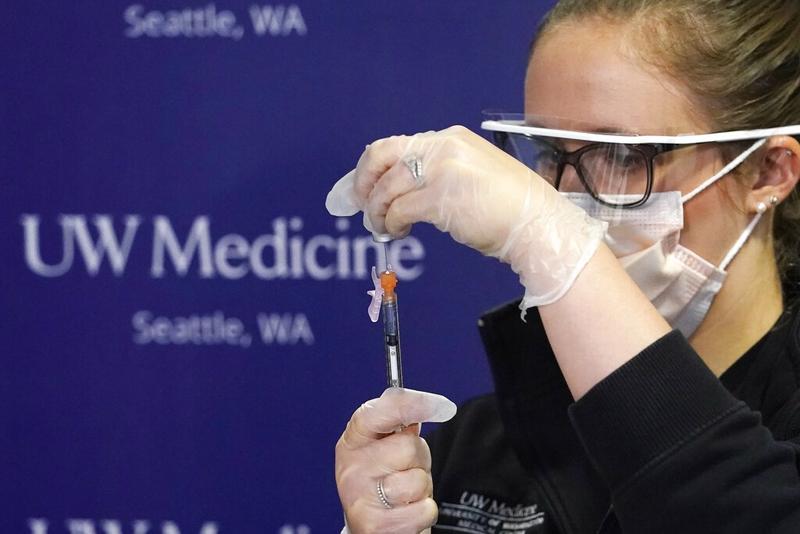 A nurse fills up a syringe with the Pfizer-BioNTech shot at UW Medicine in Seattle, the United States, on Dec 15, 2020. (ELAINE THOMPSON / AP)
A nurse fills up a syringe with the Pfizer-BioNTech shot at UW Medicine in Seattle, the United States, on Dec 15, 2020. (ELAINE THOMPSON / AP)
The United States kicked off a mass vaccination drive on Monday, hoping to turn the tide on the world's biggest coronavirus outbreak as the nation's death toll from COVID-19 passed a staggering 300,000.
The start of the desperately awaited vaccine program coincided with several European countries announcing new lockdowns amid spiraling infections, highlighting the long road to ending the pandemic.
New York nurse Sandra Lindsay became the first in the US to receive the vaccine from Pfizer and BioNTech, live on television, six days after the United Kingdom launched the West's vaccine campaign.
I hope this marks the beginning of the end of the very painful time in our history.
Sandra Lindsay, a critical care nurse in New York who was the first person in the US to be inoculated
"It didn't feel any different from taking any other vaccine," said Lindsay, a critical care nurse at the Long Island Jewish Medical Center, imploring all US citizens to "do our part" by getting vaccinated.
"I hope this marks the beginning of the end of the very painful time in our history."
The vaccinations came during one of the darkest phases of the pandemic, with cases in the US and many other countries soaring, and health experts struggling against vaccine skepticism, lockdown fatigue and uneven adherence to safety rules.
ALSO READ: Moderna virus shot found safe, effective before key FDA review
On Monday, the Netherlands prepared to enter its strictest lockdown since the pandemic began, and Britain announced new restrictions on London.
The US-which has the globe's highest death toll, and the largest number of reported cases at 16.3 million-passed 300,000 deaths just hours after vaccinations began.
"First Vaccine Administered. Congratulations USA! Congratulations WORLD!" US President Donald Trump wrote on Twitter earlier in the day, while President-elect Joe Biden tweeted "Stay hopeful-brighter days ahead."
Vaccinations also took place in California, Pennsylvania and Ohio.
Nationwide program
An initial 2.9 million doses are set to be delivered to 636 sites around the US by Wednesday, with officials saying 20 million people in the country could receive the two-shot regimen by the end of the year, and 100 million by March.
Doses are being shipped in boxes containing dry ice that can keep supplies at -70 C, the temperature needed to preserve the Pfizer-BioNTech drug.
Trials have shown the vaccine to be 95 percent effective.
READ MORE: With US now in hand, BioNTech to scale up vaccine production
But experts face a battle to convince enough people to take it to make it effective in the US, where the anti-vaccine movement is strong. According to recent Pew research, only about 60 percent of US adults say they would get a vaccine.
"My biggest concern is the level of hesitancy in the country. I really hope we are going to be able to change that," Moncef Slaoui, head of the government's vaccine rollout program Operation Warp Speed, told CBS.
Meanwhile, US health officials were on the alert for any adverse reactions.
Most reactions to the vaccine will be mild and will resolve within one to two days of onset, David Kuhar, a specialist on the Healthcare Infection Control Team of the Centers for Disease Control and Prevention, said on Monday in a webinar.
US CDC officials said on Saturday that patients with a history of severe reactions should take precautions as there are two documented cases of anaphylaxis in British healthcare workers who received the Pfizer vaccine.
Immunologist Stanley Perlman of the University of Iowa, who also was a member of the advisory panel that voted to recommend the Pfizer vaccine, said he is concerned about potential side effects that may not yet have been identified.
Agencies, Xinhua and Minlu Zhang in New York contributed to this story.


